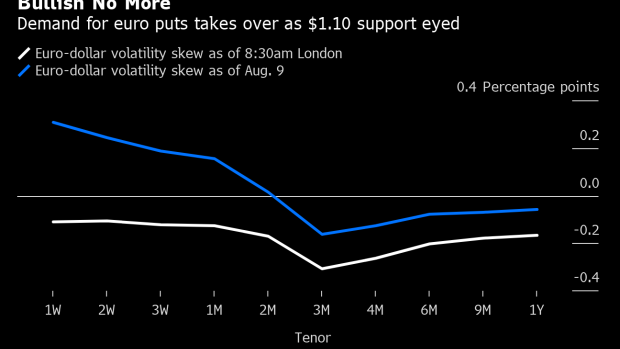Aug 16, 2019
Euro Traders Are Starting to Bet on a Break of $1.10 This Month
, Bloomberg News

(Bloomberg) -- Options traders are starting to bet on the euro dropping below psychological support at $1.10 as the European Central Bank prepares a stimulus package amid a deepening global downturn and trade uncertainty.
The odds that the euro breaks the $1.10 level by the end of August have risen to 49%, more than triple a week ago, according to Bloomberg’s options pricing model. Risk reversals, a gauge of market positioning and sentiment, show that traders are now bearish on the euro over the next week and in the long term.
Short-term volatility is staying near recent averages, suggesting a raft of monetary-policy headlines expected to hit the wire next week from the Federal Reserve’s Jackson Hole gathering aren’t seen as enough to rattle the spot market. Still, demand for options that benefit from wider ranges is gaining traction.
Headwinds for the common currency include the potential for the European Central Bank to outpace the Fed on easing measures, the risks of a no-deal Brexit and a trade war between the U.S. and the euro area, as well as a persistent trend of softer-than-expected data out of the bloc.
Next week central bankers are gathering in Wyoming for the Fed’s annual policy summit on Aug. 22-24, while the Fed and ECB’s accounts of their latest meetings are also due by then. Monetary policy developments may weigh in favor of euro bears as the most dovish policy maker on the Federal Open Market Committee, St. Louis Fed President James Bullard, said he wouldn’t “prejudge’’ the need to cut rates in September and noted solid backward-looking data.
This comes at a time when the ECB is preparing its own stimulus package, one that policy maker Olli Rehn said should be “impactful and significant.” It would be better for the central bank to overshoot than undershoot market expectations when it comes to new support measures, he said.
Intervention Aside, Euro Bears Have Little to Fear This Quarter
Investors with long positions in the euro were also reminded this week that the threat of a trade war with the U.S. hasn’t faded altogether. U.S. President Donald Trump said that the EU treats the U.S. even worse than China does and such trade-war escalation may see further pressure for the common currency, especially as euro carry trades against emerging markets are being unwound.
Charts also make the case for investors to fade any euro strength or sell technical breaks. On weekly charts, the euro is set to form a bearish candle pattern, the so-called Bearish Engulfing Line. Such a pattern has resulted in spot pressure in all six times it developed since February 2016.
- NOTE: Vassilis Karamanis is an FX and rates strategist who writes for Bloomberg. The observations he makes are his own and are not intended as investment advice
What to Watch:
- Italian Prime Minister Giuseppe Conte will address the Senate on Aug. 20, possibly leading to a confidence vote
- Kansas City Federal Reserve Bank hosts its annual central banking symposium in Jackson Hole, Wyoming on Aug. 22-24. The title of this year’s meeting is “Challenges for Monetary Policy”
- Policy maker speeches include Fed Chair Jerome Powell, Boston Fed President Eric Rosengren and Fed Vice Chair for Supervision Randal Quarles
- Economic releases include euro area inflation and man. PMI; U.S. leading indicators, PMI; Sweden and Norway unemployment; see data calendar
To contact the reporter on this story: Vassilis Karamanis in Athens at vkaramanis1@bloomberg.net
To contact the editors responsible for this story: Ven Ram at vram1@bloomberg.net, Neil Chatterjee, Anooja Debnath
©2019 Bloomberg L.P.